6 Types of Tools That Can Optimize Your Strategic Procurement Process


As opposed to transactional procurement—which focuses on price, availability, and delivery time—strategic procurement takes a broader view.
While the above parameters remain crucial, strategic procurement also emphasizes aligning sourcing activities with a company’s overall business goals, creating long-term value, and fostering strong supplier partnerships.
This has led to the development of various digital tools that enable companies to streamline and enhance their strategic procurement.
In this article, we’ll explore six types of such tools and how they can help you optimize your company’s strategic procurement process.
E-sourcing tools are software solutions and platforms that digitize and automate the sourcing process: from finding suppliers to signing a contract with them.
However, this is only the case when these tools include a digital marketplace for discovering and connecting with new suppliers registered on their platform.
If an e-sourcing tool lacks this capability—or when you want to cast a wider net in your supplier search—you might first use a supplier data platform to discover and shortlist potential suppliers.
Either way, an e-sourcing tool will then facilitate the electronic management of the sourcing process every step of the way:
From contacting prospective suppliers and collecting proposals to evaluating bids, selecting suppliers, and awarding contracts.
You can see the processes typically digitized and streamlined by e-sourcing tools here.
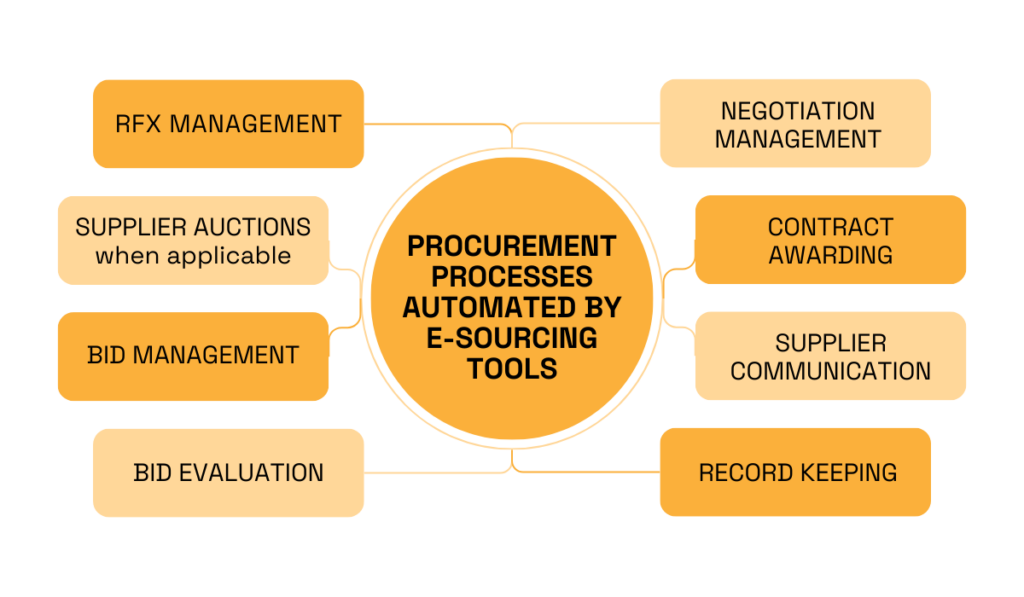
Source: Veridion
Therefore, e-sourcing tools focus on automating the entire source-to-contract (S2C) process.
In practice, this means that many previously decentralized paper, spreadsheet, and email-based sourcing tasks are now handled electronically within a unified platform.
By centralizing data and integrating workflows, an e-sourcing tool—among other things—helps reduce manual data entry errors, decreases procurement cycle times, and enhances decision-making.
Of course, such a tool needs to be intuitive and user-friendly.
Moreover, assuming you’re going for a cloud-based, subscription-driven e-sourcing tool like the one shown above, you’ll need to select between purchasing:
In the first case, your e-sourcing tool operates independently and would require integration with existing systems for seamless data flow.
In the second case, your e-sourcing solution would be part of a comprehensive platform that can include all the tools outlined in this article, which are integrated between themselves and can be integrated with other business systems, too.
Typically, these tools can be purchased as separate modules within an integrated ecosystem of platform applications.
Both Jaggaer and Coupa are good examples of such platforms.
For instance, you can see the range of Coupa’s solutions below, with their e-sourcing module specifics on the side.
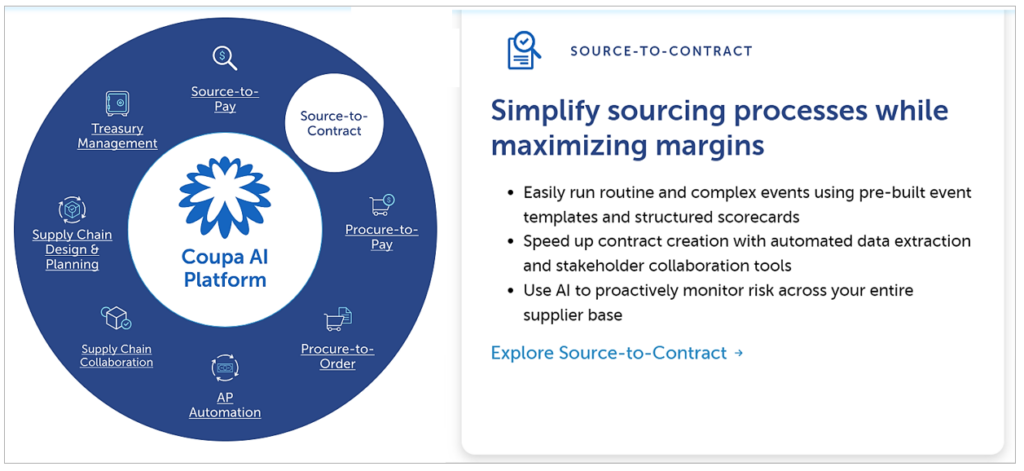
Source: Coupa
In Coupa’s S2C module, procurement team members can use templates and structured supplier scorecards to set up routine and complex sourcing events.
Then, they would use Coupa’s 10+ million supplier database or—to increase the scope of their search—a third-party supplier data platform to find potential suppliers to contact.
After that, they would gather bids from suppliers in response to sourcing events, and so on until contract award.
Overall, whether alone or as part of an integrated suite of applications, e-sourcing tools digitize, automate, and streamline the sourcing process, thereby:
As a result, they facilitate strategic procurement initiatives, such as supplier diversification, and the pursuit of sustainability, innovation, and value-creation opportunities.
Supplier data platforms collect, centralize, verify, consolidate, and enrich supplier data from diverse sources and make it available across various company systems and procurement tools.
These AI-powered, big data platforms enable your procurement team to:
Clearly, this empowers companies to make better-informed, data-driven strategic procurement decisions.
To illustrate how that’s achieved, we’ll use our supplier data platform as an example.
Veridion will provide you with access to the most comprehensive database of company data that is updated on a weekly basis.
This helps ensure that the decisions you’re making are always based on the freshest, most up-to-date information.
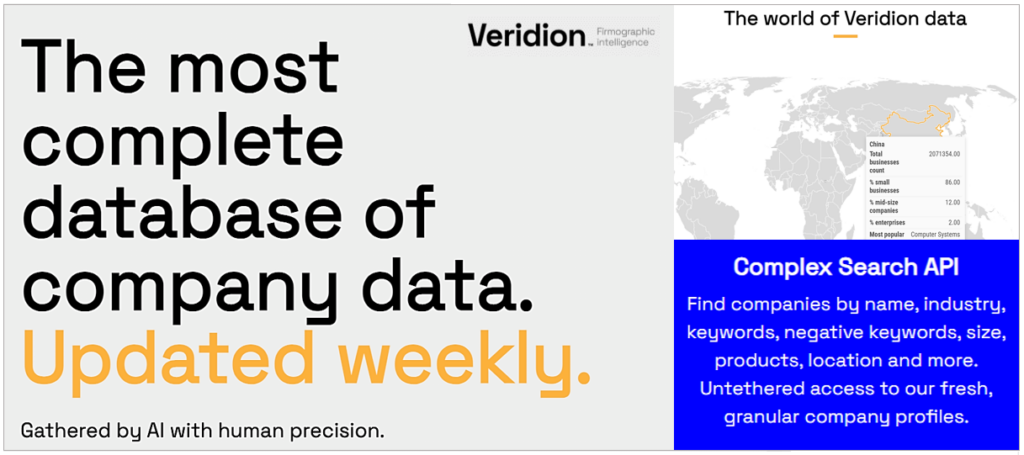
Source: Veridion
In terms of technology, Veridion harnesses the power of internet-searching AI-powered bots (machine-learning models) and an advanced search API.
In short, this API is easily integrated with your company’s procurement tools and business systems.
Combined, they give your procurement team access to the most accurate supplier data for over 80 million companies worldwide, which is crucial for informed decision-making aligned with the company’s strategic sourcing objectives.

Source: Veridion
In essence, this global database of the freshest company data and a search API, both powered by AI, automate and facilitate all the procurement tasks we listed earlier, starting with supplier discovery.
Using Veridion’s Search API, procurement professionals can use natural language to conduct highly customized searches for prospective suppliers.
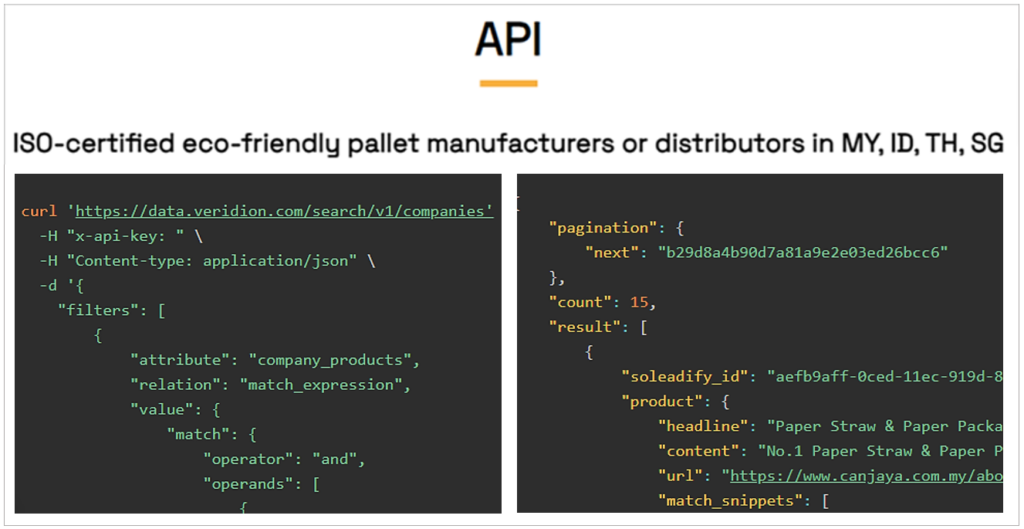
Source: Veridion
This enables procurement teams to set particular search parameters and, within moments, get a list of suppliers that offer those specific materials, components, products, or services.
As illustrated in the above image, these searches can include a range of criteria, such as quality (ISO-certified), sustainability (eco-friendly), and region (four countries in Southeast Asia).
The obtained list of potential suppliers can be further refined through Veridion’s risk assessment and market intelligence functions.
This means you gain visibility into supplier-relevant parameters, such as:
But what about vetting your existing suppliers?
For that, you can use Veridion’s Match & Enrich API functionality.
It will enrich your company’s supplier profiles with the latest info and provide automatic updates, as well as allow you to set custom risk factors and receive real-time alerts when risk events are detected.
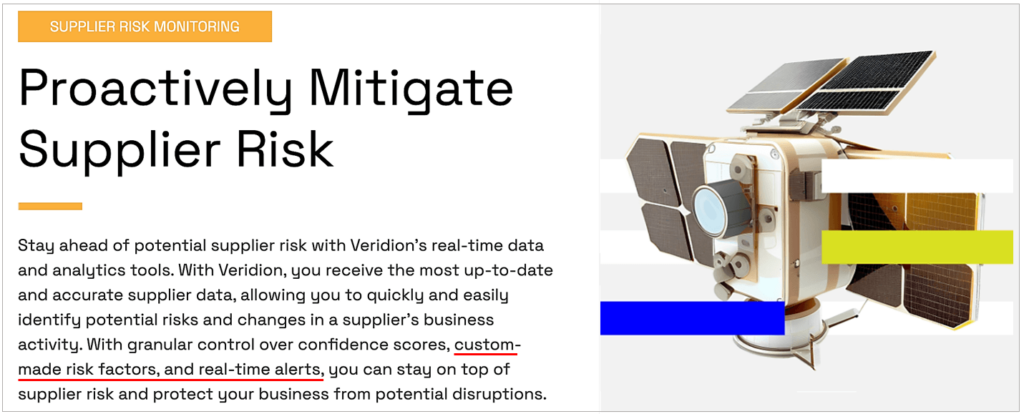
Source: Veridion
Simply put, supplier data platforms like Veridion complement your other procurement software solutions by giving your team the latest supplier data along with confidence scores.
This enables them to quickly find and more effectively evaluate suppliers by offering insights into their reliability, financial health, compliance, and overall risk profile, helping your company make informed strategic procurement decisions.
Spend analysis tools are essential for any company aiming to optimize its procurement strategy.
These tools empower companies to think strategically by providing insights into where and how they’re spending money.
More precisely, spend analysis tools collect, cleanse, classify, and analyze expenditure data to provide a comprehensive view of a company’s spending patterns.
By utilizing such tools, companies can:
Among a wide offer of spend analysis solutions, both SpendHQ and Sievo are good examples of such tools.
For instance, Sievo advertises that, with its spend analysis tool, your company can save between 3% and 11% of its annual spend.

Source: Sievo
As illustrated, this spend analytics software helps companies uncover hidden savings opportunities, monitor internal compliance, and make data-driven decisions to improve their procurement strategies.
Similar to other such solutions, this tool integrates company spend data from various sources, cleanses and normalizes it, and then applies advanced analytics to deliver the advantages listed in the screenshot below.

Source: Sievo
As highlighted, this not only gives you full spend visibility while saving time and resources.
It also enables you to make strategic decisions with transformative impacts beyond savings.
This may include sourcing goods and services from sustainable/ethical suppliers, or perhaps diversifying suppliers to make your supply base more resilient.
In summary, spend analysis tools provide procurement teams with the critical data and insights needed to drive cost savings, improve compliance, and enhance strategic decision-making.
These insights can also help them build transparent relationships with key suppliers, which is the primary goal of the next tools on our list.
While supplier data platforms help you find reliable suppliers, supplier relationship management (SRM) tools take things a step further.
They help you ensure these partnerships remain not only productive and profitable but also long-lasting, sustainable, and innovative.
Therefore, SRM tools provide your team with:
Again, just like most other strategic procurement optimization tools, your SRM solution can be purchased as a standalone, typically cloud-based software, or as part of a wider procurement management platform.
Expectedly, the market offer of such solutions is abundant, with examples including GEP SMART and Ivalua.
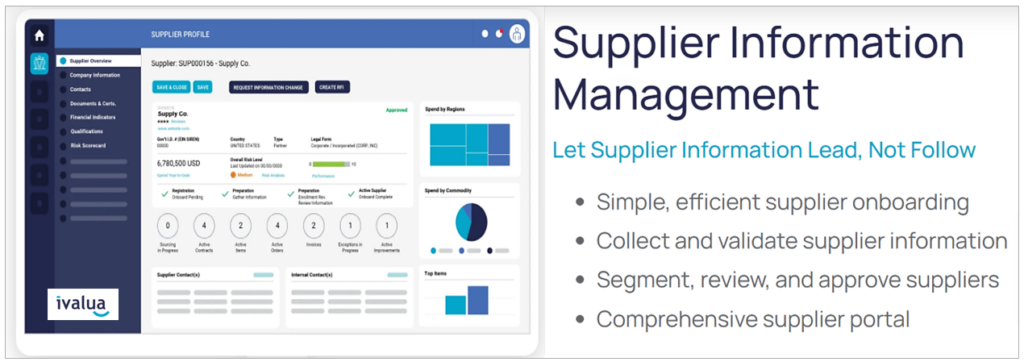
Source: Ivalua
As shown, one of Ivalua’s key features is supplier information management, which includes simple onboarding of new suppliers while efficiently collecting and validating supplier information.
Likewise, you have a range of features to set up and track supplier key performance indicators (KPIs) and conduct regular performance reviews.
Additionally, you can use supplier data and SRM functions to segment suppliers based on their strategic importance and performance metrics.
This enables you to focus on strategically developing relationships with critical suppliers while also more efficiently managing the broader supplier base and addressing inefficiencies.
Next, remember how supplier data platforms can be used to monitor for external supplier risks such as financing or ESG issues, sourcing problems, and regional instability, and provide real-time alerts?
Well, SRM tools can do the same for internal risks related to supplier performance and compliance requirements.
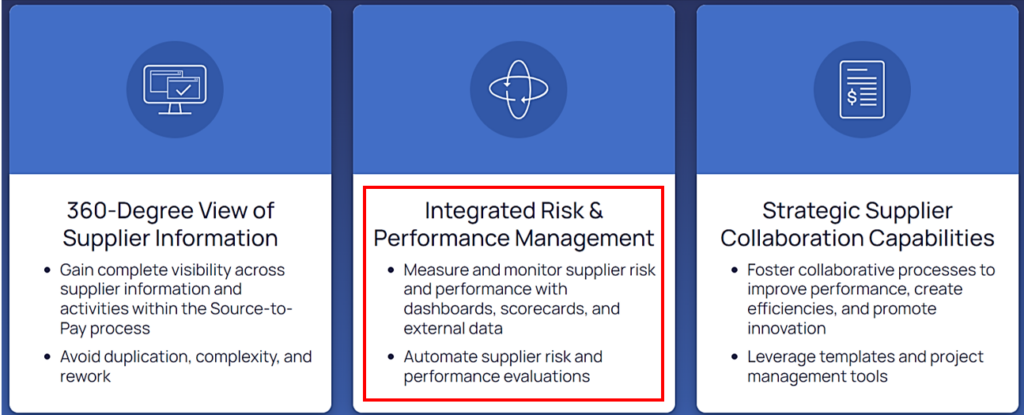
Source: Ivalua
As highlighted in the image above, SRM solutions can help your team track, identify, and mitigate risks associated with suppliers, enhance their performance through continuous monitoring, and foster innovation by working closely with strategic suppliers.
This makes them an essential tool for achieving strategic procurement goals related to supplier quality, reliability, sustainability, innovation, and more.
After you’ve used some or all of the above tools to select and contract suppliers, procure-to-pay (P2P) solutions are here to streamline the transactional aspects of procurement.
Therefore, together with e-sourcing (S2C) tools, P2P solutions complete the automation of the entire source-to-pay (S2P) process.
Again, that’s why you can choose to implement either separate S2C and P2P solutions or opt for a comprehensive S2P solution that integrates both functionalities.
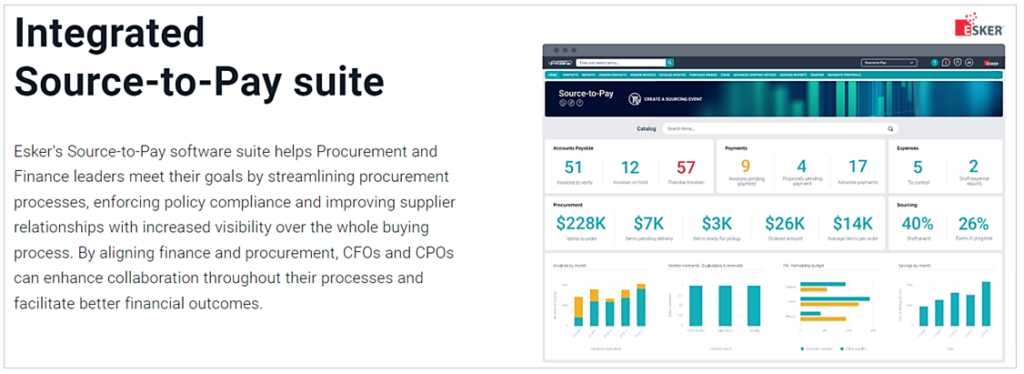
Source: Esker
In any case, P2P solutions focus on digitizing, automating, and facilitating the procurement process involving already qualified and contracted suppliers.
This covers everything from an employee making a purchase requisition to the finance department paying the supplier for delivered goods or services.
More precisely, by leveraging P2P software:
Additionally, one of the standard features of P2P solutions is to provide employees with an online shopping-like experience via approved supplier catalogs.
As illustrated below, procure-to-pay solutions bring transparency, accelerate procurement processes, and reduce unauthorized purchases and supplier non-compliance.
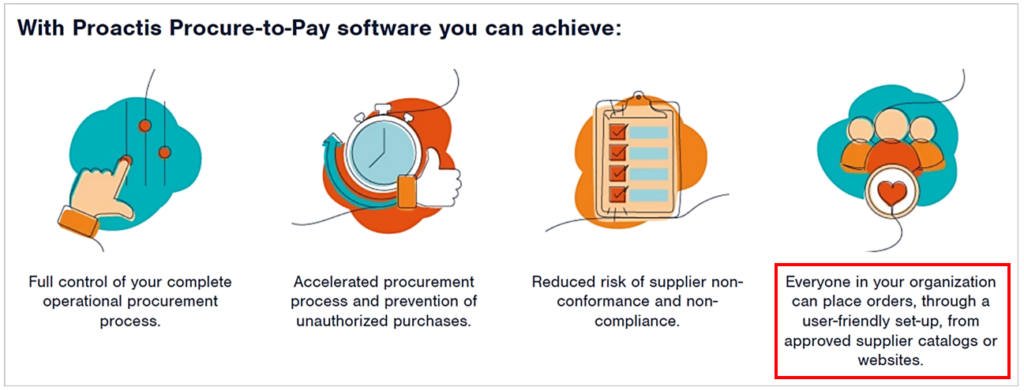
Source: Proactis
Of course, these solutions need to be integrated with other procurement tools and business systems such as accounting and enterprise resource planning (ERP) software.
When up and running, your P2P tool will provide a wealth of information crucial for identifying strategic procurement initiatives, implementing them, and tracking their progress.
Therefore, P2P solutions not only save time through automated workflows and approvals but also provide real-time visibility and control, and valuable data insights and analytics.
Contract management software is used to streamline the entire lifecycle of supplier contracts, from their preparation to management, reviews, changes, and close-out.
Their use typically begins in the initial stages of the source-to-contract process, where they can streamline contract preparation and negotiation workflows.
More precisely, before contracts are negotiated and signed, contract management software can typically provide procurement teams with:
Of course, this streamlines the S2C process and reduces procurement risks, as the below contract management solution, Icertis, suggests.

Source: Icertis
Once contracts are negotiated and agreed upon, such software helps ensure compliance with the agreed terms and conditions and optimize supplier contract management throughout the procure-to-pay process.
In practice, this involves:
For instance, here’s how GEP presents some of these features in its contract management solution.

Source: GEP
To summarize, contract management software is used throughout the procurement process to streamline contract-related workflows and approvals, as well as provide valuable insights.
Ultimately, such tools enable procurement teams to competently contract suppliers, mitigate risks, and ensure they meet contract obligations, thereby supporting cost-efficient procurement operations and strategic procurement initiatives.
Although some of the tools covered in this article focus on particular aspects of the procurement cycle, all of them play an important role in optimizing your overall strategic procurement process.
For instance, while e-sourcing tools automate your supplier-sourcing tasks, supplier data platforms ensure you’re working with the freshest information, and contract management software optimizes the contracting process.
Similarly, spend analysis tools can reveal strategic opportunities, but not without being informed by procure-to-pay solutions and facilitated by supplier relationship management tools.
Therefore, integrating and leveraging these tools effectively can help your company achieve efficient, strategic procurement operations that drive value and support long-term success.